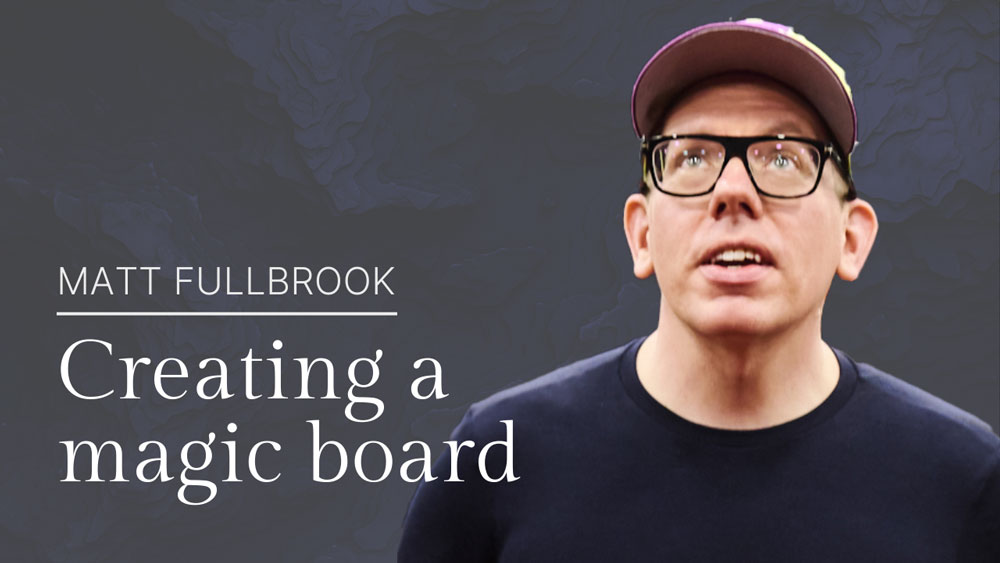Samanah Ali
6
min read
Board Governance: Create a ‘Magic’ Board
Matt Fullbrook
Corporate governance advisor, researcher, and educator | Ground-Up Governance, Fullbrook Board Effectiveness
Key takeaways
After spending many years in corporate governance, Matt Fullbrook discovered that the traditional board governance system is severely flawed.
An effective board of directors should focus on small details that are important for making strategic decisions.
Despite a desire to spend more time on strategy, boards need help measuring what this would look like in reality.
Sweeping away conventional board governance
The entire system is broken. That’s what decades of experience and studies on corporate governance brought Matt Fullbrook to conclude. By the time people in the field of board governance get to a point where they finally understand the grave mistakes made in a typical board meeting, it’s too late. Fullbrook, however, has the rare advantage of likely being the only one in Canada with 20 years of direct hands-on experience in this field, and at least 20 more years left ahead of him.
He got involved with analyzing the characteristics of an effective board of directors right in the wake of the Enron, WorldCom, Parmaat, Nortel, and Tyco corporations scandals. At the time, he didn’t think anyone would care much about corporate governance, and just casually got himself involved in some projects in this field. To his surprise, that was exactly when public interest in this industry spiked.
According to a 2019 study by the Diligent Institute, 70 percent of all investor demands over the past decade have focused on governance. MSCI also reports that “governance-related risks may have had a more immediate impact on equity prices than social issues or environmental issues.”
At the start of Fullbrook’s career in 2003, he served as a manager of the Clarkson Centre for Board Effectiveness at the University of Toronto’s Rotman School of Management for 16 years, where he oversaw all of its board governance projects.
Ever since then, he has consistently attended conferences, taught courses on effective board structures, practices, and policies, and now has his own consulting company, podcast, and newsletter. Throughout his 20-year career, Fullbrook has advised over 250 boardrooms.
“It gave me the time and the opportunity to embrace a lot of conventional thinking, question it and let go of it, and still have lots of time to keep going,” he said in an interview with Horizon Search.
While boards are a necessary component of every corporation, there is great flexibility in what that can look like. What Fullbrook finds strange, however, is that certain elements of uniformity exist among all of them.
“They (boards) can look and feel like a lot of different things, […] the fact that they look and feel most of the same everywhere is pretty strange,” he said.
Even on an operational level, Fullbrook says that 90 percent of what happens in any given boardroom is optional, but they still follow the same cooperative model and expect to have different results.
In a way, they are helpless.
Consulting with a hundred organizations about what changes boards could implement would have very little impact on board performance in the long term as no one would admit that the entire system is flawed.
“The real spirit of what I’m hoping to do is help people realize it’s optional,” Fullbrook said. “By trying to convince organizations to try these things, my hope is that they'll realize, ‘Oh, that wasn't very hard, what else can we try?’ Instead of just continuing to do the same stuff that they and everybody else have done.”
Another trend he noticed is that in most board governance surveys, a majority of boards want to spend more time on strategy. According to a survey of over 2000 directors and senior executives in 46 countries conducted by one of the world’s largest professional services firms, KPMG, a critical priority of boards is to align boardroom talent with company strategy.
A majority of the board of directors who responded also saw a need for improvement in “the board’s overall ability to challenge management and help steer the company through uncertainty.”
“The problem is, they don't know what being strategic feels like to them,” Fullbrook said. Without a clear measure of what being “strategic” really means, boards will always want to spend more time on strategy.
What strategic board management looks like
Fulbrook is now working to design his classes to help different types of directors identify what being “strategic” really means.
“We can say at the end of a 15-minute exercise, on a scale of one being deeply operational to 10 being highly strategic, where did that feel? And they'll say eight or nine, and I'll say, great, steal that. Do that instead of doing the stuff that you usually do,” he further explained.
Fullbrook doesn’t believe in a one-size-fits-all approach, as every corporation has different requirements. What he advocates for instead is for corporate governance to be “intentional about cultivating effective conditions for making decisions.”
What usually comes in the minds of these board directors is creating pre-reads and what should be on the agendas. Things that seem trivial but evidently influence decision-making are often easily neglected. A simple example of this can be providing coffee in the room or adjusting the lighting, temperature, and room layout.
To be clear, such decisions should be made based on scientific research. For example, according to a University of Toronto Scarborough study, in certain situations, dimming the lights can help people make more rational decisions and settle negotiations more easily.
“Let's ask ourselves, okay, what result do we actually want from this meeting, and how can we be intentional about the conditions, both physical and psychological, and so on, to feed into the decision in a way that's going to serve us best,” Fullbrook said. “We're gonna get it wrong, but we want it to be better than being completely accidental.”
Many corporations also admit that they need more creativity in their approach, but when Fullbrook asks directors what they’re doing to access that creativity, the answer he gets is, “That’s not what we do.”
“We've got boards, or a group of people, senior executives, and directors who’ve wished things were different but don't realize that that difference or the change is at hand. All they need to do is try, but they don't really see that as part of the work they're supposed to be doing,” said Fullbrook.
The conventional understanding of good governance for many years has been that boards serve as “catastrophe-avoiding” and “compliance” machines. “It took me a really long time to realize that it's the entire conventional system working against them (board of directors),” said Fullbrook.
“In a board room, that magic should be funnelled into action, but usually, we're not even looking for the magic in the first place.”
Part of the challenge in making this happen is the lack of peaceful cooperation among the directors. Boards consist of people from different skill sets, expertise, experience, and personalities, so naturally, there would be some level of disagreement among them.

(Yan Krukau/Pexels)
Fullbrook believes that it is impossible to satisfy everyone in every manner, so either everyone would have to be equally unhappy throughout the entire meeting, or there could be an active effort to “try and understand what it takes to activate each of these people individually and try to give everybody their time to shine.”
Communication barriers to good governance
“Most boards that I meet, take neither path and instead choose to just sort of show up and hope that things go okay,” Fullbrook said. Communication is severely lacking. Even when a senior executive is brought in with a lot of hope for improvement in a company, CEOs are often the first to rant about their relationship issues. According to a PwC survey on board effectiveness, 89% of executives say one or more directors on their board should be replaced.

(Source: PwC)
In fact, it’s one of the most common problems that Fullbrooks is approached with. CEOs become frustrated when the board frequently delves into operational matters and seldom engages in strategic discussions. Again, when he asks them what they’ve tried to make it better, their response goes something like, “I’ve tried nothing, and I’m all out of ideas.”
“I think everybody thinks it’s everybody else’s job to show up better,” Fullbrook said. This is where he urges people to communicate expectations clearly.
Another communication issue that Fullbrook has identified is in the corporate jargon. The fundamental inspiration for his Groud-Up Governance newsletter was a realization that there wasn’t enough effort made to ensure that all jargon holds the same meaning.
“I see very frequently in boardrooms disagreements that materialize around a lack of a shared understanding of the vocabulary we're using. Without us realizing that that's the problem, we think we disagree more fundamentally, but really, we're just using the same word to mean different things, and I swear, the most important one is corporate governance,” Fullbrook said.
“Go out and read 20 articles on corporate governance, especially good governance, and try to find two definitions that are the same, you can't.” Through his newsletter, Fullbrook hopes to break down corporate governance jargon in a way that is easy to understand.
“What I want is to spark a universal movement where everybody changes as a result,” he said.
References
Bloomberg. (n.d.). The value of corporate governance in a more Sustainable World. Bloomberg.com. https://sponsored.bloomberg.com/article/axa/the-value-of-corporate-governance-in-a-more-sustainable-world
KPMG. (n.d.). (rep.). Building a great Board. Retrieved September 16, 2023, from https://assets.kpmg.com/content/dam/kpmg/be/pdf/2019/10/building-a-great-board-pulse-survey.pdf. PwC. (2023). (rep.). Board effectiveness: A survey of the C-suite.
University of Toronto. (2014, February 20). The way a room is lit can affect the way you make decisions. ScienceDaily. https://www.sciencedaily.com/releases/2014/02/140220132004.htm



